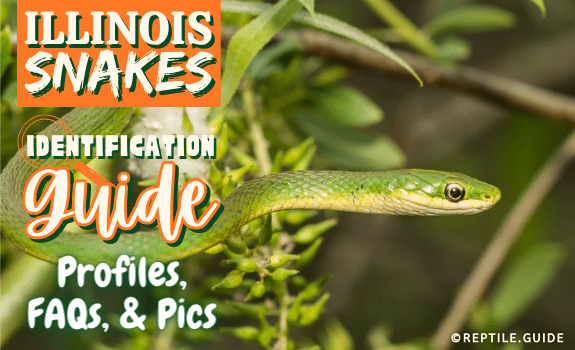From the threatened and elusive Kirtland’s snake to the hardy and abundant DeKay’s brownsnake, this Midwestern state will surprise you with its snake diversity.
There are 40 species of Illinois snakes in total. Let’s take a look at the state’s four venomous species, the most frequently seen harmless species, and its most iconic snakes.
I’ll provide you with tips on how to stay safe around snakes, the best ways to coexist with them, and supply you with a list of helpful contacts at the end.
In This Article
In Short
The highlights of what you’ll learn from this guide:
- There are four species of venomous snakes in Illinois.
- The best way to get over your fear of snakes is to educate yourself.
- It’s best to give a snake its space and leave it alone if you see one in the wild.
- 40 species of snakes call Illinois home, most of which belong to the Colubridae family.
- Most snake bites result from people attacking, relocating, or pestering a snake in some way.
- Snakes are way more beneficial than they are harmful; we need them to keep our ecosystem balanced.
Illinois Snake Identification Basics
There are several significant components to consider when identifying snakes.
The most important features include:
- Size – Different species in Illinois range in maximum size, from less than a foot, to seven feet in length. Taking note of how long a snake is can help you distinguish it from similar-looking species.
- Pupils – All venomous snakes in the state have elliptical pupils, while all of the non-venomous snakes have round pupils.
- Location – Geographic location and habitat type will help you narrow down which snakes are likely to be in the area where you found the snake.
Some snakes have specific habitat preferences. The Western ribbon snake, for example, prefers wet habitats and is only found along the Mississippi River in Illinois.
There are many snakes in Southern Illinois that you won’t encounter anywhere else in the state. If you’re looking at snakes in Northern Illinois, they definitely won’t be species like the great plains rat snake or red-bellied mud-snake. - Coloration – A snake’s pattern and coloration are some of the most valuable identifiers, yet they can also be deceiving. You definitely won’t mistake a solid green species like the smooth green snake for a patterned rattlesnake species. However, it’s easy to mix up species like the lined snake, plains garter snake, and common garter snake.
You’re most likely to successfully identify a snake when combining all of these attributes.
Because snake characteristics often vary geographically, this guide is only for Illinois snake Identification.
Quickly Identifying Illinois Venomous Snakes
All venomous snake species in Illinois are pit vipers. They belong to a group of venomous snakes called the Viperidae family.
Pit vipers share traits that make them easily distinguishable from the harmless snake species of Illinois.
They all have:
- Elliptical pupils – Vertical pupils shaped like cat eyes
- Heat-sensing pits – Large sensory pits between each eye and nostril to help the snake locate prey
- Broad, triangular heads – Heads widened by venom glands behind the jaw
- A single row of scales under the tail – Most harmless species have two rows of scales on the underside of the tail
Fun Fact: People often mislabel these species as poisonous snakes in Illinois. However, poison is something you ingest.
Copperhead
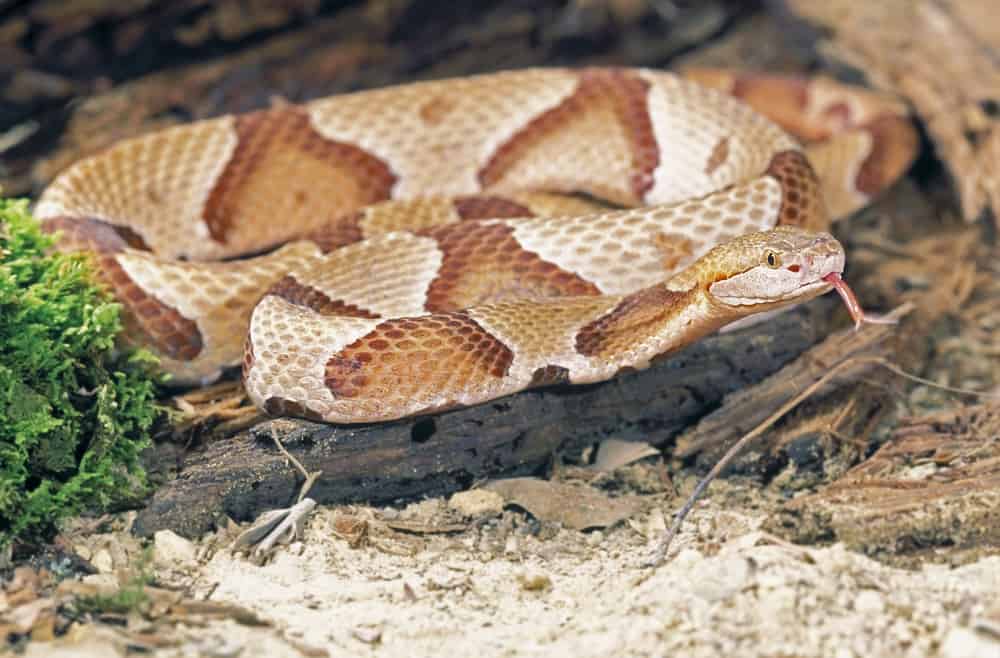
| Scientific Name: | Agkistrodon contortrix |
|---|---|
| Range: | Southern third of Illinois, in the Lower Illinois River valley
You may find these snakes in Central Illinois |
| Adult Size: | 24-36 inches |
| Description: | Heavy-bodied
Elliptical pupils and sensory pits on a broad head Copper-red head, rusty-brown or yellow-brown body, keeled scales, reddish-brown hour-glass shaped bands Juveniles have a green tail tip |
| Habitat: | Woodlands, rocky hillsides, and along forest edges |
| Diet: | Diet generalist, mainly mice, but also birds, lizards, other snakes, insects, and amphibians |
| Venomous/Non-Venomous: | Venomous |
Cottonmouth
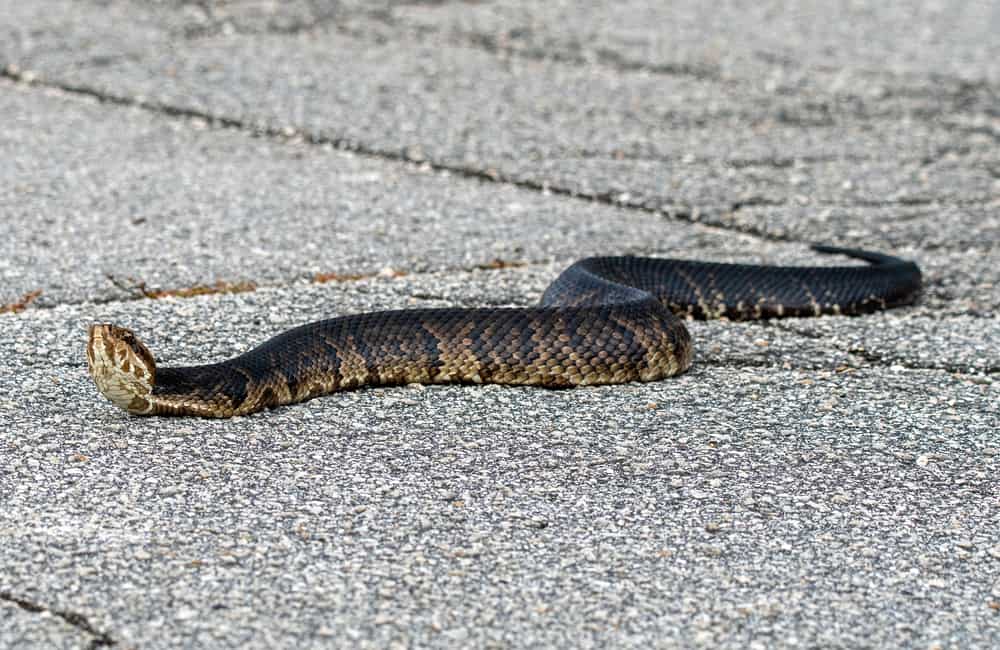
| Scientific Name: | Agkistrodon piscivorus |
|---|---|
| Range: | Tip of Southern Illinois |
| Adult Size: | 30-42 inches |
| Description: | Flat, wide head
Elliptical pupils and heat-sensing pits Thick-bodied with keeled scales May have dark bands or be solid black or brown Juveniles have a green tail tip |
| Habitat: | Swamps, sloughs, and lakes |
| Diet: | Mice, fish, birds, lizards, amphibians, insects, and other snakes |
| Venomous/Non-Venomous: | Venomous |
Timber Rattlesnake
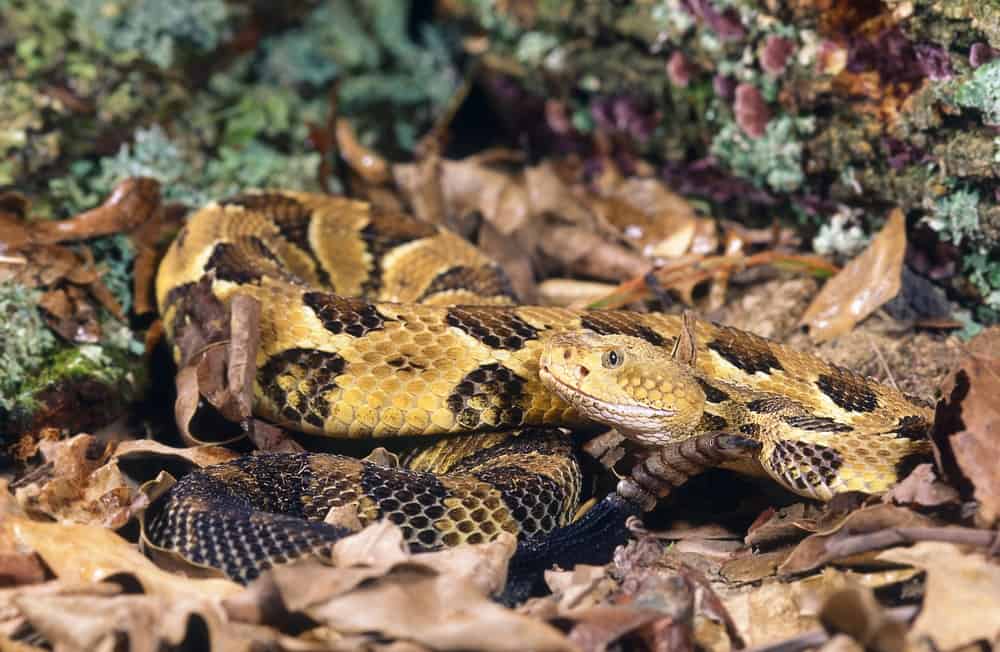
| Scientific Name: | Crotalus horridus |
|---|---|
| Range: | Southern third of Illinois and along the Mississippi River in the west
Found in the lower Illinois River valley and the Mississippi River valley |
| Adult Size: | 36-60 inches |
| Description: | Distinct rattle at the end of the tail
Elliptical pupils and sensory pits on a flat, wide head Gray or yellow with dark, V-shaped bands, a rust-colored dorsal stripe, and keeled scales May have a dark line between the eye and jaw |
| Habitat: | Forested bluffs, rocky outcroppings, and fields |
| Diet: | Rodents, birds, frogs, and lizards |
| Venomous/Non-Venomous: | Venomous |
Massasauga
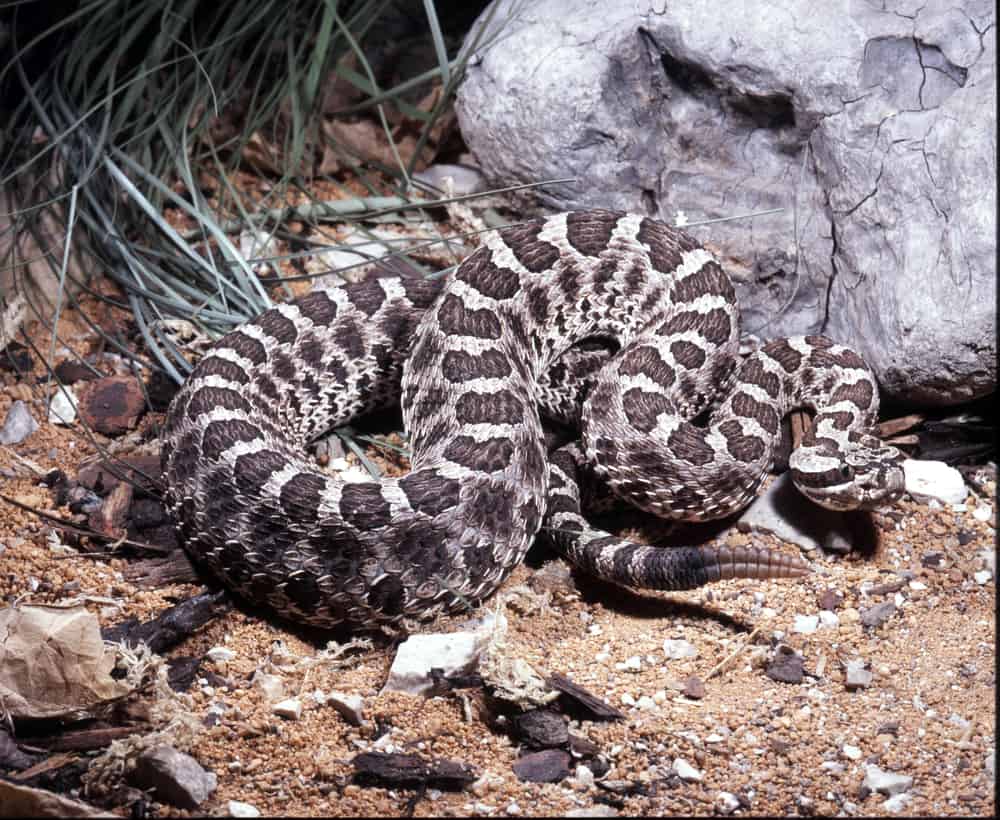
| Scientific Name: | Sistrurus catenatus |
|---|---|
| Range: | Northern two-thirds of Illinois
The only venomous species not found in Southern Illinois |
| Adult Size: | 18-30 inches |
| Description: | Keeled scales
Rattle at the tip of the tail Elliptical pupils and a wide head typical of pit vipers Gray body with dark blotches down the back and three rows of dark spots along the sides |
| Habitat: | Wet prairies, bogs, and fields |
| Diet: | Mice, birds, frogs, and other snakes |
| Venomous/Non-Venomous: | Venomous |
Most Common Snakes in Illinois
Out of the 40 species of Illinois snakes, the most common snakes in Illinois, in order of most to least abundant, are the:
- Common Garter Snake
- Northern Cottonmouth
- Dekay’s Brownsnake
- Common Watersnake
- Plains Garter Snake
- Gray Rat Snake
Common Garter Snake
True to its name, the common garter snake is the most prevalent garter snake in Illinois. There are three other species native to the state.
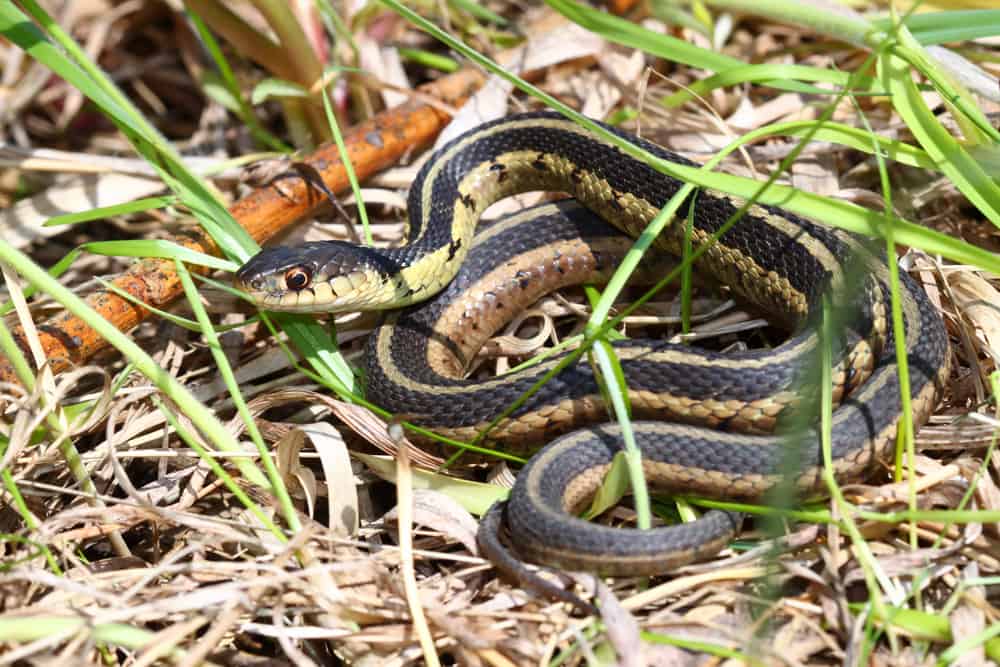
| Scientific Name: | Thamnophis sirtalis |
|---|---|
| Range: | Statewide |
| Adult Size: | 18-26 inches |
| Description: | Round pupils
Thin snakes with keeled scales Three yellow stripes run down a black, brown, or green body |
| Habitat: | A variety of habitats, including woodlands, meadows, marshes, along streams, and urban areas |
| Diet: | Earthworms, insects, amphibians, mice, and birds |
| Venomous/Non-Venomous: | Non-venomous |
Dekay’s Brownsnake
If you’re a gardener, you’ll want brownsnakes around. These little snakes help keep pesky slugs and insects under control.
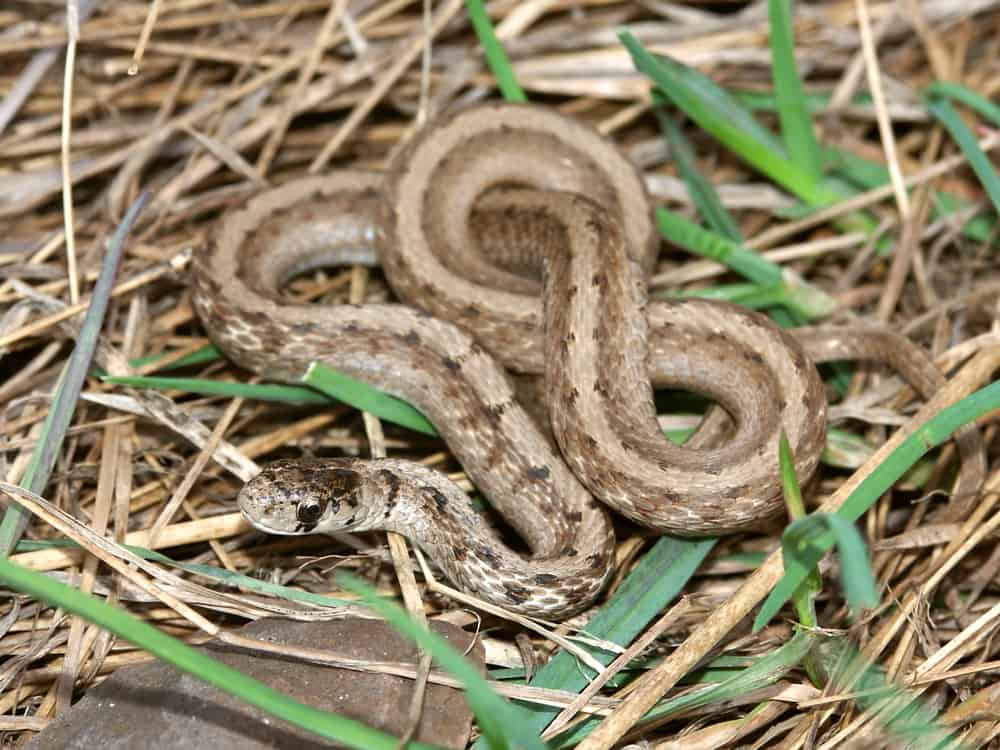
| Scientific Name: | Storeria dekayii |
|---|---|
| Range: | Statewide |
| Adult Size: | 9-13 inches |
| Description: | Keeled scales and round pupils
Brown or gray with a lighter dorsal stripe bordered by black dots |
| Habitat: | Urban areas and a variety of wet habitats, including floodplains, marshes, swamps, prairies, and woodlands |
| Diet: | Insects, slugs, and earthworms |
| Venomous/Non-Venomous: | Non-venomous |
Common Watersnake
There are five species of water snakes in Illinois. The common watersnake is the only one that occurs throughout the entire state.
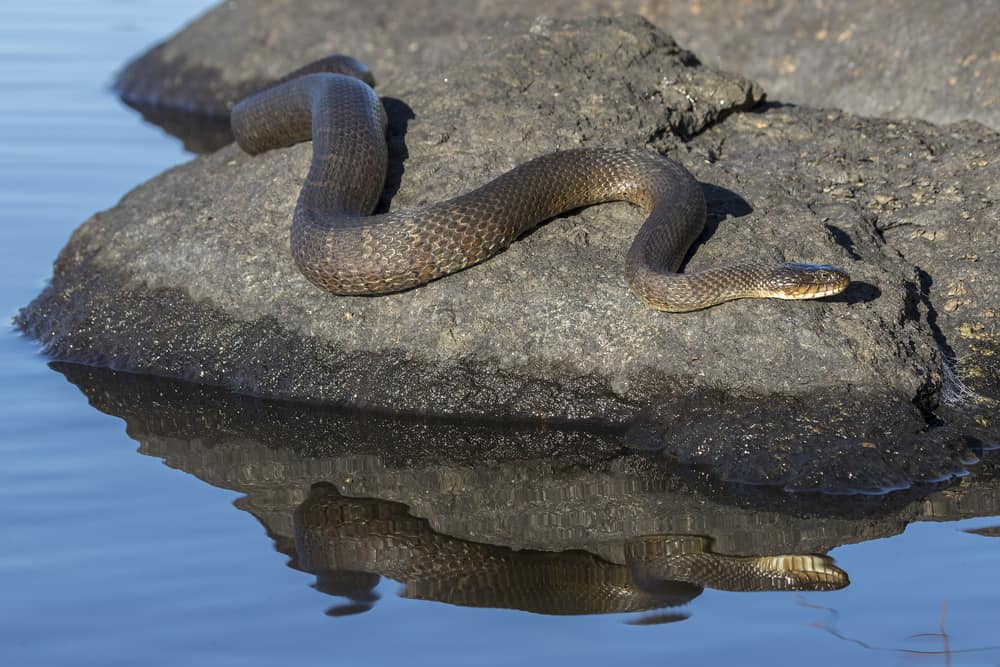
| Scientific Name: | Nerodia sipedon |
|---|---|
| Range: | Statewide |
| Adult Size: | 22-42 inches |
| Description: | Round pupils
Gray to dark brown with keeled scales May have reddish-brown or black markings, or no pattern at all |
| Habitat: | Natural and man-made bodies of water, including lakes, ponds, streams, marshes, and ditches |
| Diet: | Fish and amphibians |
| Venomous/Non-Venomous: | Non-venomous |
Plains Garter Snake
Plains garter snakes are cold tolerant, and you may see them on warmer days throughout winter.
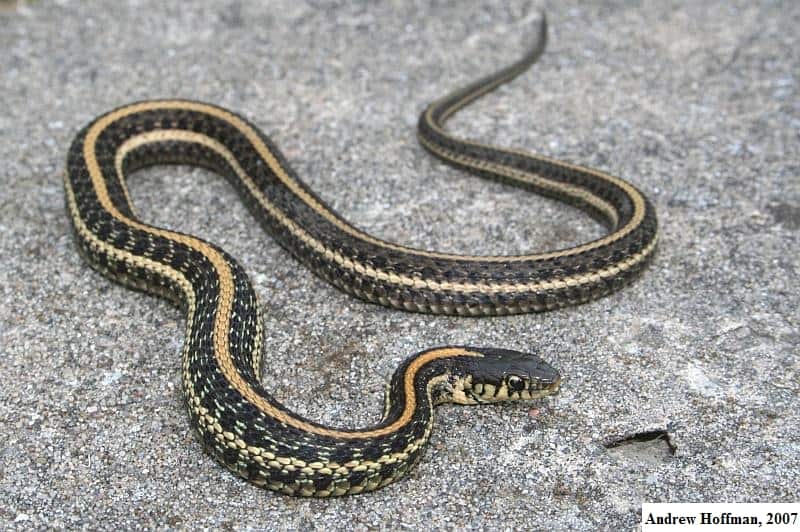
Image credit: Andrew Hoffman via creativecommons.org
| Scientific Name: | Thamnophis radix |
|---|---|
| Range: | Northern half of Illinois |
| Adult Size: | 15-28 inches |
| Description: | Round pupils on a small, pointed head
Brown, black, or green body with keeled scales Yellow or orange dorsal stripe with a yellow-gray stripe on each side and black bars on the lips |
| Habitat: | Fields, marshes, meadows, and river valleys |
| Diet: | Amphibians, fish, small mammals, birds, earthworms, and other invertebrates |
| Venomous/Non-Venomous: | Non-venomous |
Gray Rat Snake
Areas with large rodent populations often attract gray rat snakes.
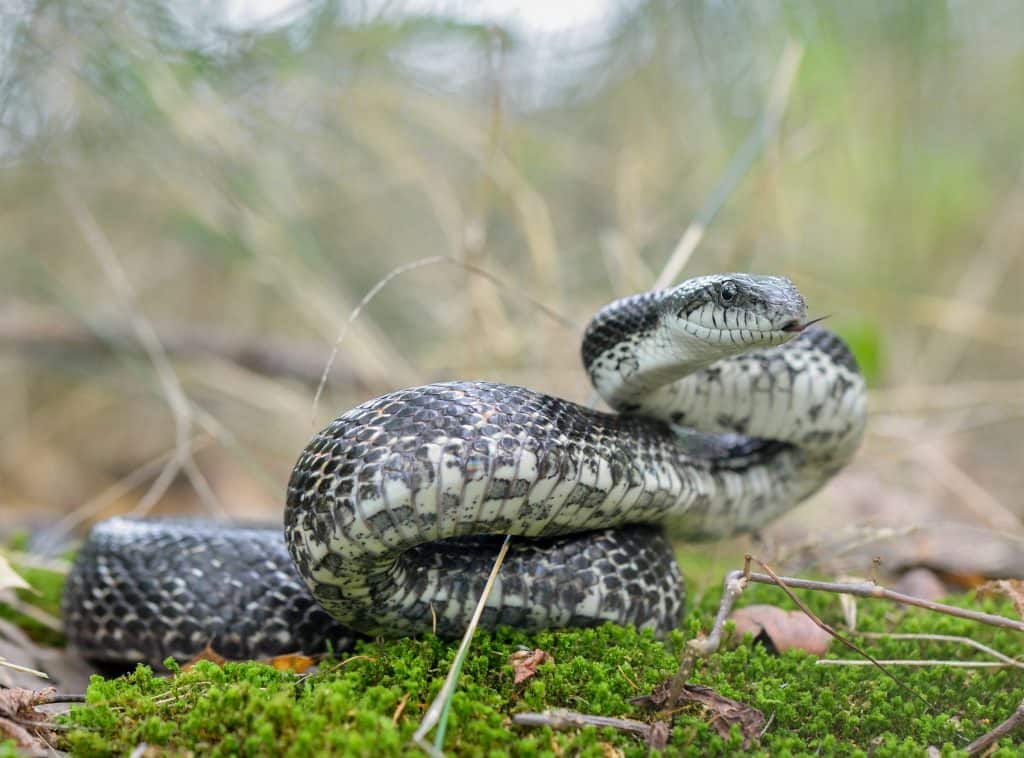
Image credit: Will Brown via creativecommons.org
| Scientific Name: | Pantherophis spiloides |
|---|---|
| Range: | Southern two-thirds of Illinois |
| Adult Size: | 42-72 inches |
| Description: | Weakly keeled scales along the back
Round pupils on a head slightly wider than the neck Coloration is variable, from solid black, to gray, or brown with a blotched pattern Black and white checkered pattern on ventral scales |
| Habitat: | Woodlands, farmland, shrubs, and thickets |
| Diet: | Known for consuming rodents, but also other small mammals and birds |
| Venomous/Non-Venomous: | Non-venomous |
Iconic Illinois Snake Species
There’s something to appreciate about every snake, but there are a few exceptional snakes found in Illinois that you must see.
Take a look at these iconic snake species that call Illinois home.
Hognose Snakes
There are two species of hognose snake in Illinois, the Western and Eastern hognose snakes.
The Western hognose snake is listed as threatened in the state of Illinois. It has a habitat preference for sand prairies and mostly lives along the central Illinois River and the upper Mississippi River.
Its specialized habitat choice leaves it vulnerable to habitat destruction.
The Eastern hognose snake lives throughout the state. Like the Western hognose, it prefers habitats with sandy and loose soil.
Its coloration is widely variable. Individuals can be olive, brown, black, gray, tan, orange, or red. They often have dark blotches, but may also appear patternless.
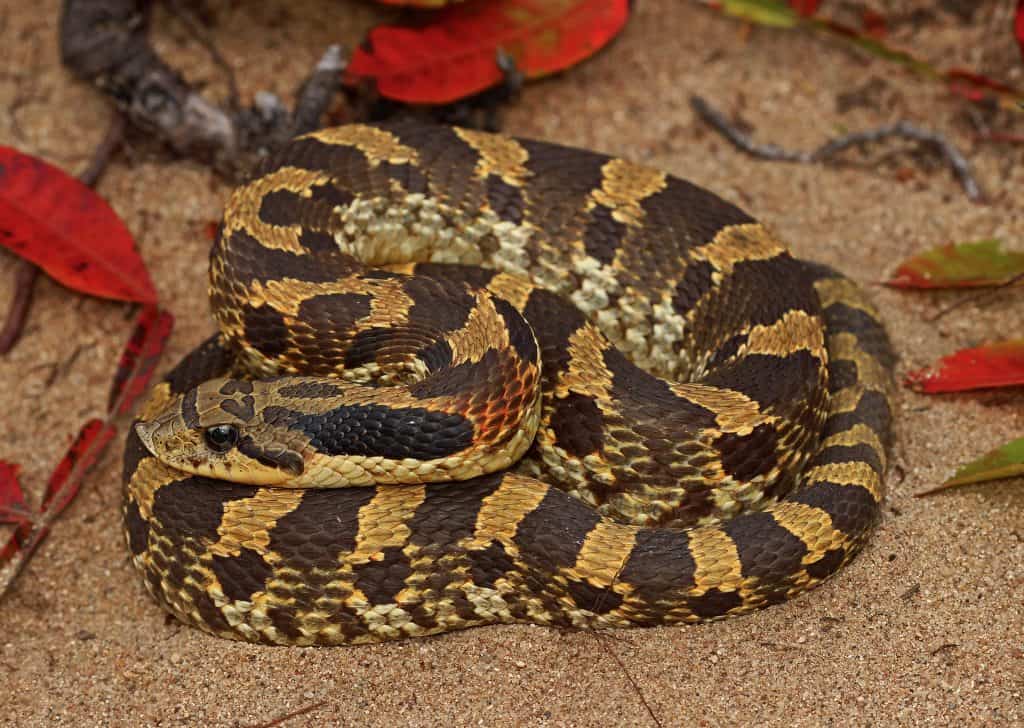
Image credit: 2ndPeter via creativecommons.org
Hognose snakes have unique defensive displays. When threatened, a hognose widens its neck, inflates its body, and lets out a long hiss, earning them the nickname “puff adder”.
If this tactic doesn’t do the trick, a hognose will resort to faking its own death. It rolls over, twitches, lets its tongue hang out of its open mouth, and emits a foul smell.
Eastern Kingsnake
You might hear the Eastern kingsnake called the common kingsnake or chain kingsnake.
Kingsnakes are ophiophagous, meaning they eat other snakes, including venomous species.
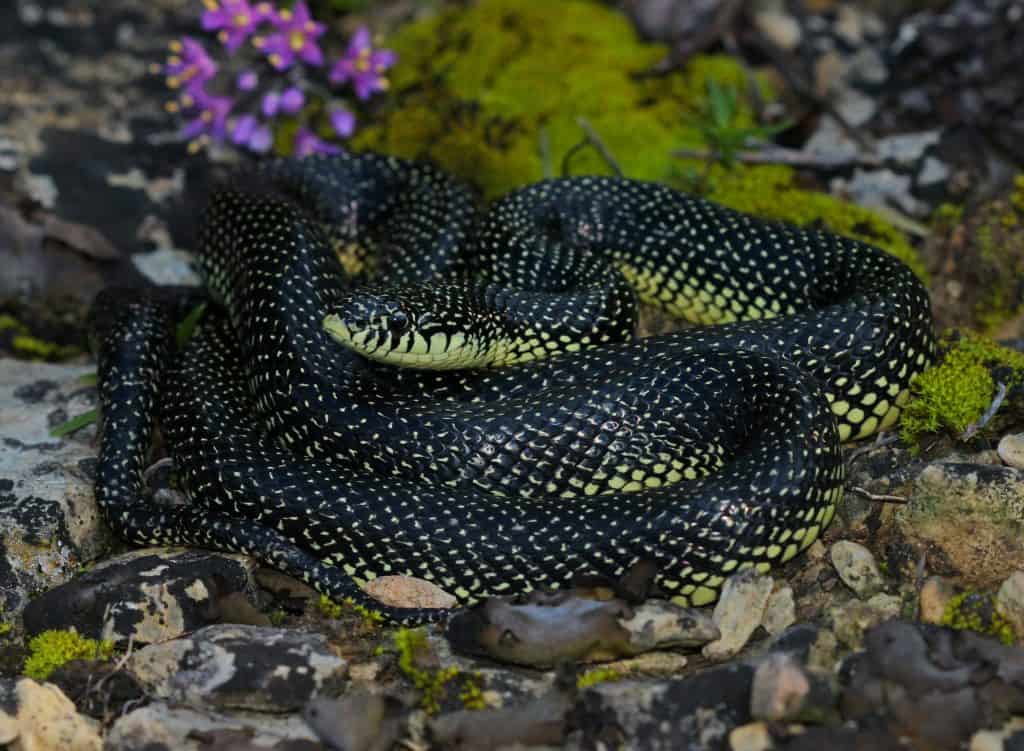
Image credit: 2ndPeter via creativecommons.org
The Eastern kingsnake may be confused with other black snakes in Illinois, like the North American racer and gray rat snake.
The Eastern kingsnake has smooth, shiny scales, speckled with white or yellow dots that form a chain-like pattern.
Some individuals may appear solid black, and others may have narrow bands.
Red-Bellied Snake
It may look drab from above, but take a closer look, and you’ll see its shockingly bright orange-red belly.
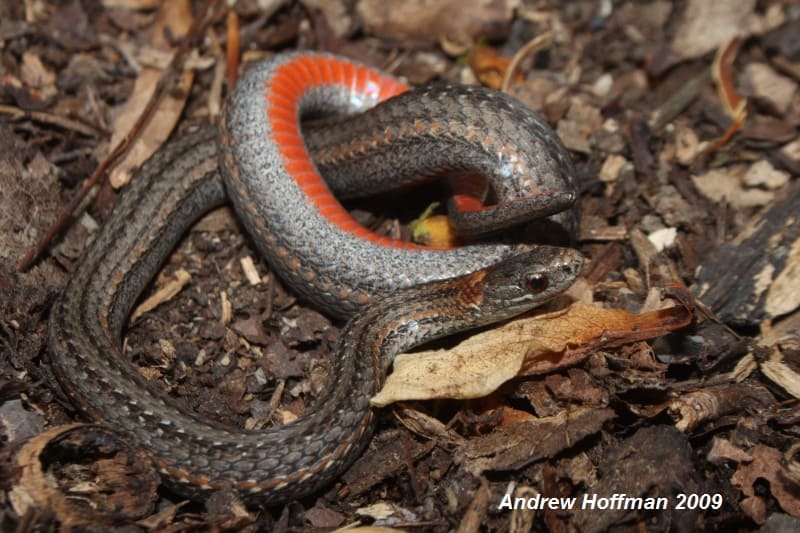
Image credit: Andrew Hoffman via creativecommons.org
The red-bellied snake is a small species, averaging 8 to 10 inches long.
It prefers moist woodland habitats and mainly eats earthworms and slugs.
When threatened or consuming prey, they exhibit an unusual lip-curling behavior, showing their small teeth.
Snakes Native to Illinois
There are 40 species of Illinois snakes.
While there are many different types of snakes in the state, all but four species are part of the world’s most inclusive snake family, the Colubridae family.
The remaining species are the four venomous snake species, which belong to the Viperidae family.
Below is a comprehensive list of every species found in Illinois, organized by genera.
Some genera are well represented, with multiple species occurring within state lines, like the garter snake genus (Thamnophis).
Other species, such as the lined snake, are the only representatives of their genus in the state.
Racers
- North American Racer Coluber constrictor
Mud Snakes
- Red-Bellied Mud Snake Farancia abacura
Rat Snakes
- Gray Rat Snake Pantherophis spiloides
- Eastern Fox Snake Pantherophis vulpinus
- Western Fox Snake Pantherophis ramspotti
- Great Plains Rat Snake Pantherophis emoryi
Worm Snakes
- Common Wormsnake Carphophis amoenus
- Western Wormsnake Carphophis vermis
Kingsnakes
- Prairie Kingsnake Lampropeltis calligaster
- Eastern Kingsnake Lampropeltis getula
- Eastern Milksnake Lampropeltis triangulum
Massasaugas
- Eastern Massasauga Sistrurus catenatus
Earth Snakes
- Smooth Earthsnake Virginia valeriae
Green Snakes
- Rough Green Snake Opheodrys aestivus
- Smooth Green Snake Opheodrys vernalis
Lined Snakes
- Lined Snake Tropidoclonion lineatum
Rattlesnakes
- Timber Rattlesnake Crotalus horridus
Water Snakes
- Common Watersnake Nerodia sipedon
- Southern Watersnake Nerodia fasciata
- Plain-Bellied Watersnake Nerodia erythrogaster
- Diamond-Backed Watersnake Nerodia rhombifer
- Mississippi Green Watersnake Nerodia cyclopion
Garter Snakes
- Plains Garter Snake Thamnophis radix
- Common Garter Snake Thamnophis sirtalis
- Eastern Ribbon Snake Thamnophis sauritus
- Western Ribbon Snake Thamnophis proximus
Gopher Snakes
- Gopher snake Pituophis catenifer
Scarlet Snakes
- Northern Scarlet Snake Cemophora coccinea
Hognose Snakes
- Eastern Hognose Snake Heterodon platirhinos
- Western Hognose Snake Heterodon nasicus
Crayfish Snakes
- Queen Snake Regina septemvittata
- Graham’s Crayfish Snake Regina grahamii
Centipede Snakes
- Flatheaded Snake Tantilla gracilis
Coachwhip Snakes
- Coachwhip Masticophis flagellum
Kirtland’s Snake
- Kirtland’s Snake Clonophis kirtlandii
American Moccasins
- Copperhead Agkistrodon contortrix
- Cottonmouth Agkistrodon piscivorus
Ring-Necked Snakes
- Ringneck Snake Diadophis punctatus
American Brown Snakes
- Red-bellied Snake Storeria occipitomaculata
- Dekay’s Brown Snake Storeria dekayii
What You Need to Know
Snakes are a fundamental part of the Illinois ecosystem.
They’re a food source for many animals, including mammals, birds, other reptiles, frogs, and fish.
Snakes also keep pest populations in control by consuming rodents, insects, and other invertebrates that cause damage and spread disease.
This balance makes them invaluable to farmers, gardeners, and homeowners.
Snakes help prevent the spread of disease by consuming sick animals or animals that host Lyme disease-carrying ticks.
Educating yourself on snakes and their natural history is the best way to overcome any fears you may have.
We must coexist with these incredible creatures. They aren’t out to get you as their reputation leads you to believe.
Snake Safety
Venomous Snakes
Venomous snake bites are rare in the United States and even more so in Illinois.
Compared to states like Texas, Illinois has a meager amount of venomous snakes.
While the scarlet snake and milk snake may try to fool you, the venomous coral snake doesn’t live in this state.
If you do encounter one of the four venomous species found here, keep your distance, and you’ll be fine.
Snakes primarily use their venom for subduing prey. They’ll typically use other defensive mechanisms to scare you off before resorting to biting.
For more information on what to do if a venomous snake bites you, visit the Illinois Poison Center’s website.
Treading Carefully in Snake Habitat
There are several ways you can prepare yourself when entering potential snake habitats.
The best practices for staying safe include:
- Stay on well-worn or paved paths.
- Wear sturdy shoes and long pants.
- Watch where you step, reach, and sit.
- Keep your pets on a leash and watch where they put their noses.
Snakes like to hide under rocks, wood piles, debris, tall grass, and vegetation.
If You Encounter a Snake
If you come across a snake in the wild, don’t panic.
Snakes are generally shy creatures and want to be left alone. Give it space, leave the area, or allow it to depart on its own.
Most snakes will try to get away as quickly as possible if you get too close. However, some rely on their excellent camouflage skills to avoid predators (you).
Pit vipers are prone to staying as still as possible to hide in place, making it easier to step on them.
Besides the accidental misstep, the most common causes of snake bites are people attempting to handle, relocate, or injure a snake.
It’s best to leave wildlife alone.
When to Call for Help
The only times you’ll need to call for help are if you or your loved ones are in danger.
It’s illegal to remove native snakes without a permit in Illinois. Contact your local animal control or a licensed wildlife trapper if you need a snake removed from your property.
If a venomous snake bites you, contact 911 immediately.
Antivenom is most effective when administered within a few hours, so don’t wait for symptoms to appear.
Seek emergency veterinary care if a venomous snake bites your pet. Most pets survive if treated quickly.
Useful Resources
Emergencies
Illinois Poison Center Helpline: 1-800-222-1222
Free Snake Relocation Directory on Facebook
Pet Emergencies
American Society for the Prevention of Cruelty to Animals (ASPCA) Animal Poison Control Center 888-426-4435
Pet Poison Hotline 800-213-6680
Additional Information
The Illinois Department of Natural Resources Wild About Illinois Snakes!
The University of Illinois species lists.
Articles Related to Illinois Snake Identification
If you enjoyed learning how to identify snakes of Illinois, take a look at these guides:
- Missouri Snakes Identification Guide (With Tips to Staying Safe)
- North Carolina Snakes Identification (Species Info, Pics, & More)
- Alabama Snakes Identification Guide: Species Background & Traits
Check out other articles our experts have written on snakes! You’re sure to learn something exciting.
Have you seen these snakes in the wild? Let us know in the comments!
